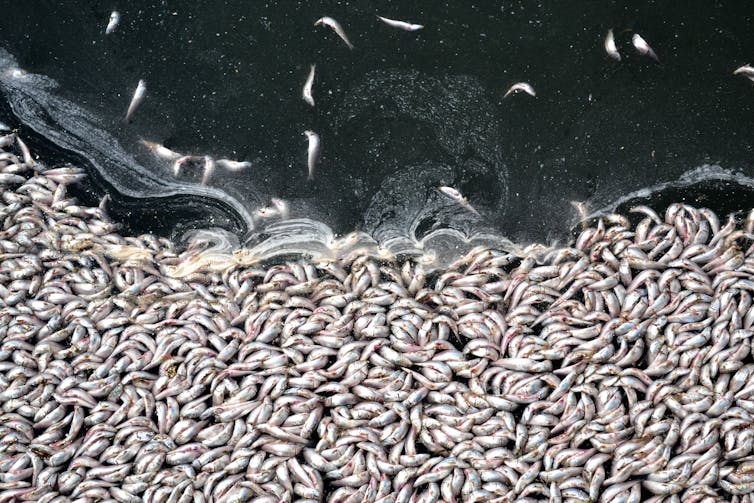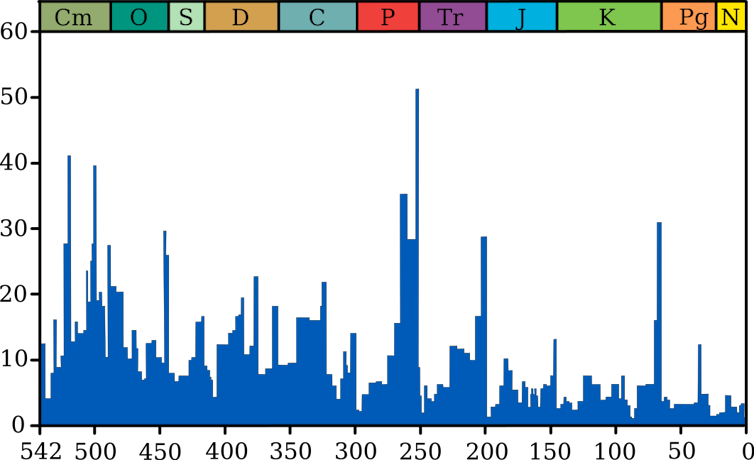Volcanic eruptions once caused mass extinctions in the oceans – could climate change do the same?
- Written by Jeremy D. Owens, Assistant Professor of Earth, Ocean and Atmospheric Science, Florida State University
All animals, whether they live on land or in the water, require oxygen to breathe. But today the world’s oceans are losing oxygen,[1] due to a combination of rising temperatures and changing ocean currents. Both factors are driven by human-induced climate change.
This process has the potential to disrupt marine food chains[2]. We already know that large hypoxic, or low-oxygen, zones can be deadly. If hypoxia expands in both size and duration, it is possible to cause widespread extinction of marine life, which has happened previously in Earth’s history.
We investigate natural, ancient changes in ocean oxygenation and the biological effects as a way of understanding the natural response to potential future climate scenarios. In a recent study[3], we examined links between a major volcanic event that occurred millions of years ago and changes in ocean oxygen levels. Like human activities today, this event released massive amounts of carbon dioxide and other greenhouse gases into the atmosphere.
We found that this episode appeared to trigger significant oxygen losses in the world’s ocean that lasted over one million years. Our research adds to growing evidence that marine oxygen contents are dramatically affected by warming temperatures and other climate-related feedbacks caused by the release of greenhouse gases.
Climate change is reducing the ocean’s ability to hold oxygen and increasing marine organisms’ need for it.Are our oceans suffocating?
Scientists widely agree that human activities – mainly fossil fuel combustion, deforestation and agricultural practices – are releasing carbon dioxide and methane into the atmosphere at unprecedented rates[4]. For the past several decades, research on climate change impacts has focused on global warming, sea level rise and ocean acidification. Now, loss of ocean oxygen is starting to receive attention.
The world’s oceans have lost more than 2 percent of their dissolved oxygen reservoir[5] over the past five decades. In many places local factors such as nutrient pollution are making the problem worse. In U.S. waters, major hypoxic zones regularly form in the Gulf of Mexico[6], the Great Lakes[7] and along the Pacific coast[8]. Other coastal waters are similarly impacted around the world[9].
Hypoxia can devastate fish catches. For example, a major fish kill in the Philippines[10] in 2002 was directly associated with declining oxygen levels in the water. A similar event occurred in Redondo Beach, California in 2011 when hypoxic conditions over several days decimated the local fish population[11]. Ultimately, these events have significant impacts on humans[12], since 40 percent of the world’s population lives within roughly 60 miles of the ocean. Millions of people depend on fish[13] for food, income or both.
 Dead sardines float on the surface at King Harbor Marina in Redondo Beach, California, March 10, 2011 during a deoxygenation event.
AP Photo/Noaki Schwartz[14]
Dead sardines float on the surface at King Harbor Marina in Redondo Beach, California, March 10, 2011 during a deoxygenation event.
AP Photo/Noaki Schwartz[14]
Linking ancient oxygen loss to a marine mass extinction
Past volcanic eruptions are probably our only ancient analogs to modern release of greenhouse gases from human activities. To understand how these events affected the oceans, we turned to ancient marine rocks that can record the relationship between carbon dioxide releases from volcanoes, marine oxygen levels and extinction events.
One such event, which occurred 183 million years ago during the Early Jurassic, is called the Toarcian Oceanic Anoxic Event[15]. It is renowned for major volcanism and the seventh-largest mass extinction in Earth’s history, which occurred predominantly in the oceans. The volcanism that occurred was much larger in scale than all modern volcanoes, and would have released massive amounts of greenhouse gases to the atmosphere, warming the planet dramatically.
We applied a new and novel tool – thallium isotopes – to determine the timing and amount of oxygen loss from the oceans during this event. Thallium is a soft, silvery metal that is found in various ores, including balls of manganese on the ocean floor[16]. Isotopes are atoms of the same element that have slight mass differences because they contain varying numbers of neutrons.
Numerous minerals form in the ocean, often through reactions that involve oxygen. But the amount of free oxygen in seawater is not constant in the modern ocean, and has also varied in time. When oxygen is abundant in the ocean, manganese oxides deposit on the ocean floor, and thallium – especially its heavier isotopes – stick to them. By analyzing ancient marine sediments and looking for shifts in thallium’s isotopic value, we hypothesized that we could track the progressive loss of ocean oxygen.
 Ammonite fossil from Alberta, Canada. This ammonite evolved at the end of the Toarcian Oceanic Anoxic Event and associated marine mass extinction and was used to help determine the age of the rocks.
Benjamin Gill, CC BY-ND[17]
Ammonite fossil from Alberta, Canada. This ammonite evolved at the end of the Toarcian Oceanic Anoxic Event and associated marine mass extinction and was used to help determine the age of the rocks.
Benjamin Gill, CC BY-ND[17]
To do this, we collected specific dark-colored sedimentary rocks from this time period at sites in Canada and Germany, which represented two different ancient oceans. We then dissolved each layer of rock to form a liquid, and isolated and purified the thallium in each sample.
We found that thallium isotopes shifted in two stages during this event. First the oceans became less oxygenated during the onset of massive volcanism, approximately 183.8 million years ago to 183.1 million years ago. Then the oceans lost even more oxygen, coinciding with the most intense phase of volcanism, which occurred from 183.1 million years ago to 182.6 million years ago.
This work shows for the first time that the global ocean lost oxygen coincidentally with the onset of volcanism[18]. Importantly, this happened at the onset of a known extinction called the Pliensbachian-Toarcian mass extinction event[19]. In other words, the first signs of the extinction in the fossil record coincide with oxygen loss in the oceans.
We now think that this state of low-oxygen marine conditions lasted for over one million years and across two extinction pulses. The second phase of deoxygenation was more expansive, thus causing a larger extinction. It happened even though the atmosphere contained enough oxygen to support life, much like today. Furthermore, the duration of low oxygen conditions was similar to another event[20] that occurred 94 million years ago with biological consequences.
 Ocean mass extinction events over the past 542 million years. Time (millions of years ago) runs from left to right on the horizontal axis. The vertical axis shows percent of species lost.
Smith609/Wikimedia, CC BY-SA[21][22]
Ocean mass extinction events over the past 542 million years. Time (millions of years ago) runs from left to right on the horizontal axis. The vertical axis shows percent of species lost.
Smith609/Wikimedia, CC BY-SA[21][22]
A global warming threshold?
The Intergovernmental Panel on Climate Change recently released a Special Report on Global Warming of 1.5°C[23], which called for immediate action to limit climate change to levels that will minimize environmental and ecosystem stress. Scientists broadly agree that this means preventing global average temperatures from rising more than 1.5 degrees Celsius above preindustrial levels.
The report notes that if temperatures increase by 2°C instead of 1.5°C, substantially more oxygen loss will occur in the oceans. This makes it important to continue studying ancient impacts of oxygen loss on the extinction record, so that scientists can better predict future climate scenarios. It is also important to identify areas that will be most impacted by ocean oxygen loss and limit the environmental effects that will occur as our planet continues to warm.
References
- ^ losing oxygen, (theconversation.com)
- ^ disrupt marine food chains (theconversation.com)
- ^ recent study (doi.org)
- ^ unprecedented rates (doi.org)
- ^ more than 2 percent of their dissolved oxygen reservoir (doi.org)
- ^ Gulf of Mexico (www.noaa.gov)
- ^ Great Lakes (theconversation.com)
- ^ Pacific coast (www.npr.org)
- ^ similarly impacted around the world (www.wri.org)
- ^ major fish kill in the Philippines (doi.org)
- ^ decimated the local fish population (doi.org)
- ^ significant impacts on humans (dx.doi.org)
- ^ Millions of people depend on fish (www.fao.org)
- ^ AP Photo/Noaki Schwartz (www.apimages.com)
- ^ Anoxic Event (en.wikipedia.org)
- ^ balls of manganese on the ocean floor (www.livescience.com)
- ^ CC BY-ND (creativecommons.org)
- ^ coincidentally with the onset of volcanism (doi.org)
- ^ Pliensbachian-Toarcian mass extinction event (doi.org)
- ^ another event (dx.doi.org)
- ^ Smith609/Wikimedia (commons.wikimedia.org)
- ^ CC BY-SA (creativecommons.org)
- ^ Special Report on Global Warming of 1.5°C (www.ipcc.ch)
Authors: Jeremy D. Owens, Assistant Professor of Earth, Ocean and Atmospheric Science, Florida State University

